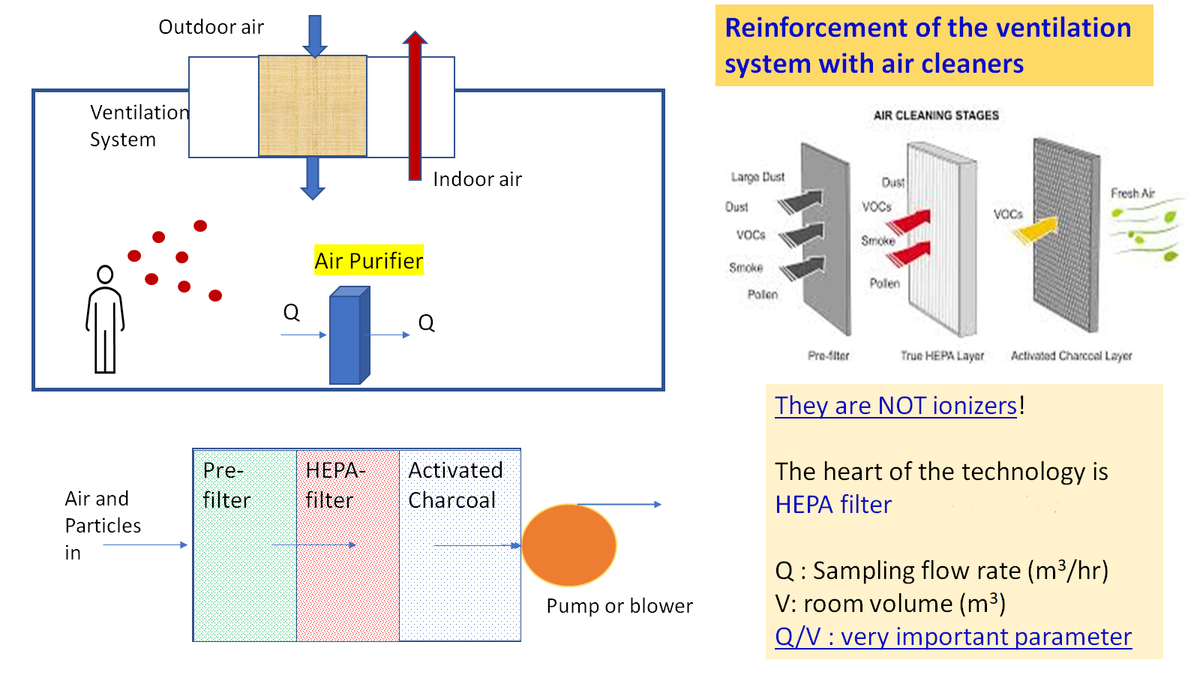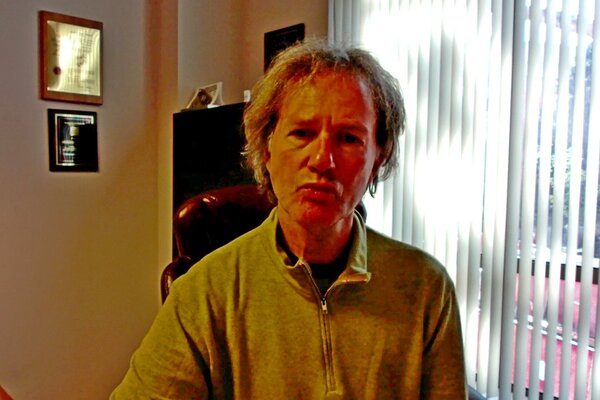Public health & Prevention, Prevention & Public health, Article
How indoor air purification can protect dentists and patients from transmission of viruses
04 March 2024
The latest indoor air purifiers equipped with high-efficiency particulate (HEPA) air filters should be deployed in dental clinics as well as doctors’ surgeries, nursing homes and other indoor environment, writes environmental engineer Constantinos Sioutas. As well as protecting patients and practitioners from Covid-19, the filters also provide protection against flu viruses, allergies, and air pollution.
To date, the global COVID-19 pandemic caused by the SARS-CoV-2 virus has resulted in more than 800 million confirmed cases and more than seven million deaths, according to the World Health Organization (WHO). The estimated economic cost of the COVID-19 pandemic related to lost productivity and adversely affected health is estimated at more than $16 trillion. The COVID-19 pandemic revealed how unprepared the world was to respond to it, despite the knowledge gained from previous pandemics.
Among the most important errors made was the initial inability to realise the importance of airborne transmission of the virus, despite the repeated efforts of the international aerosol scientific community. The first position letter from the aerosol community was sent to the WHO in April 2020, but it took the organisation three months to even acknowledge the possibility of airborne transmission of Covid19. According to the Centers for Disease Control (CDC). We now know that over 90% of Covid19 infections are through airborne transmission.
How can an infected person transmit the virus? Humans produce large amounts of particles below 5µm as they breathe and talk. These smaller particles travel freely in the air and carry their viral content hundreds of metres from their point of emission. During a sneeze or cough, a “spray” of droplets usually larger than 10µm (20–200µm) in diameter is emitted through exhalation from an infected person. A person can inhale microscopic aerosol particles consisting of the solid residual components of evaporated sneeze or cough droplets, which are quite small (<5μm) and can remain in the air for hours.
Most research on airborne diseases prior to the COVID-19 current pandemic had initially focused on “violent” exhalation phenomena such as sneezing and coughing. Far less attention was paid to aerosol transmission, but today we know that this mode of transmission plays a very important role in the high transmissibility of COVID-19, because of the small size of aerosols and their ability to remain in the air for several hours. Even the larger particles produced by coughs and sneezes evaporate very quickly into much smaller sizes, in the range of 1 micrometre or less, and remain in the air for many hours.
The measures that have been adopted – such as physical distancing, hand washing, avoiding crowding, and wearing a face mask – were all steps in the right direction. Using a face mask has many advantages, but also some limitations: although masks are very effective at filtering particles larger than 5 micrometres, their effectiveness drops to 50% or even less for smaller particles, even if a person wears the mask tightly. A leak of just 2% in the face mask reduces this particle-removal efficiency to levels even lower than 50%. Moreover, it has been shown that surgical masks from around the world are loaded with semi-volatile and volatile organic compounds (VOCs), polycyclic aromatic hydrocarbons (PAHs), and reactive carbonyls at ng to μg/mask levels. Naphthalene, a carcinogen, was the most abundant mask-borne PAH, accounting for over 80% of total PAH levels. They found that heating the masks at 50°C for as little as 60 minutes lowers the total VOC content by up to 80%, providing a simple method to limit our exposure to mask-borne VOCs.

The importance of air purification
The most effective way to drastically reduce concentrations of even very small particles indoors is ventilation combined with the use of portable air purifiers. This has been a well-known indoor air-cleaning strategy in the aerosol science community for decades but has not yet caught the attention of the public, and especially government authorities and policy makers. These portable air purifiers equipped with high-efficiency particulate air (HEPA) filters to remove particles can completely clean indoor spaces of 50-100 m2 in about 15-20 minutes, depending on the model.
The choice of air cleaner depends mainly on the volume of the room in which it will be used. A rule of thumb is that the sample flow rate of the cleaner should be such that the volume of air in that room will pass through the purifier (and will be filtered) about four to five times and hour. In the USA, the certification programme of the Association of Home Appliance Manufacturers (AHAM) provides the public with more guidance on choosing these appliances. It is important to distinguish these HEPA filter-based devices from purifiers that use ionization. The use of the latter devices may be problematic in indoor environments, including the dental clinic, especially where there are susceptible populations (such as children, adults with pre-existing conditions, the elderly), because they produce ozone in concentrations exceeding the air quality-standard of 60 ppb and will also result in the formation of secondary organic aerosols (SOA) indoors in high concentrations.
The high effectiveness of indoor air purifiers against COVID-19 has been proven in recently published studies. For example, a study by the University of Southern California’s aerosol laboratory – conducted to investigate the effectiveness of air-cleaning systems in reducing student exposure to airborne particles in USC classrooms – showed that combining an air cleaner with a ventilation and air-conditioning system (HVAC) reduced indoor particle concentrations by 90-95% within 10 to 15 minutes of operating in the classroom.
Another recent study sought to determine how HEPA filters stand up to real-world conditions and installed HEPA filters in two fully occupied COVID-19 wards — a general ward and an intensive care unit (ICU). The study showed that aerosols migrated rapidly between the various ward sub-compartments, suggesting that social distancing alone cannot prevent nosocomial transmission of SARS-CoV-2 as this fails to mitigate longer-range (>2m) transmission. The air-cleaning units (ACU) reduced levels of particulate matter considerably throughout the ward space, indicating its potential as an effective intervention to reduce the risk posed by infectious airborne particles.
The main conclusions from all this is that airborne transmission is the most important way of transmitting COVID-19 and that the use of a face mask offers limited protection, especially in indoor spaces with a high concentration of people. The use of indoor air purifiers with HEPA filters and effective ventilation systems is imperative to protect the public from Covid19.
The use of these systems should be recommended by regulatory authorities as necessary for public protection in places such as doctors’ offices, hospitals, dental clinics, restaurants, schools, public transport, department stores, workplaces, nursing homes.
Furthermore, these cleaning systems protect not only against Covid19 but also against flu, allergies, as well as air pollution which is responsible for eight to nine million deaths worldwide every year.
Bibliography
Aldekheel, M., Altuwayjiri, A., Tohidi, R., Jalali Farahani, V., & Sioutas, C. The role of Aldekheel M., Altuwayjiri A., Tohidi R., Jalali Farahani V and Sioutas C.*” The role of portable air purifiers and effective ventilation in improving indoor air quality in university classrooms “. International Journal of Environmental Research and Public Health, 19, 14558. https://doi.org/10.3390, 2022
Association of Home Appliance Manufacturers’ (AHAM) certification program- https://www.ahamdir.com/room-air-cleaners/
Barber, Victoria P., et al. "Indoor Air Quality Implications of Germicidal 222 nm Light." Environmental Science & Technology (2023), https://doi.org/10.1021/acs.est.3c05680
Butler, M. J., Darren Sloof, Christine Peters, A. Conway Morris, T. Gouliouris, R. Thaxter, V. L. Keevil, and C. B. Beggs. "Impact of supplementary air filtration on aerosols and particulate matter in a UK hospital ward: a case study." Journal of Hospital Infection 135: 81-89., 2023.
Drewnick F, Pikmann, J , Fachinger F, Moormann L, Sprang F & Borrmann S. Aerosol filtration efficiency of household materials for homemade face masks: Influence of material properties, particle size, particle electrical charge, face velocity, and leaks, Aerosol Science and Technology, DOI: 10.1080/02786826.2020.1817846, 2020.
Jin et al, Environmental Science &Technology,2021, doi.org:10.1021/acs.est.1c04591.
Lewis. D. “Mounting evidence suggests coronavirus is airborne — but health advice has not caught up: Nature 583, 510-513, 2020 doi: https://doi.org/10.1038/d41586-020-02058-1, 2020.
Morawska, L., and Milton D.K. "It is time to address airborne transmission of COVID-19." Clin Infect Dis 6 (2020): ciaa939.
Morawska, L., Tang, J.W., Bahnfleth, W., Bluyssen, P.M., Boerstra, A., Buonanno, G., Cao, J., Dancer, S., Floto, A., Franchimon, F. and Haworth, C., How can airborne transmission of COVID-19 indoors be minimised? Environment international, 142, p.105832, 2020.
Tang JW, Caniza MA, Dinn M, Dwyer DE, Heraud JM, Jennings LC, Kok J, Kwok KO, Li Y, Loh TP, Marr LC. An exploration of the political, social, economic and cultural factors affecting how different global regions initially reacted to the COVID-19 pandemic. Interface Focus. 2022 Feb 11;12(2):20210079.

Biography
Constantinos Sioutas is the Fred Champion Professor at the Department of Civil & Environmental Engineering of the University of Southern California (USC) in Los Angeles, USA. He received his undergraduate education in mechanical engineering at the Aristotle University of Thessaloniki, Greece, and came to the U.S.A in 1986 as a Fulbright Foundation fellow. He received Master of Science degrees in Mechanical Engineering and in Aerospace Engineering, both from the University of Minnesota. He then received his Doctor of Science degree in 1994 from the Harvard School of Public Health in the department of Environmental Engineering. He started his academic career in 1995 as an assistant professor of aerosol science at Harvard, before joining the faculty of the USC in January 1998. He started his academic career in 1995 as an Assistant Professor of Aerosol Science at the Harvard, prior to joining the faculty of the University of Southern California (USC) in January 1998. He is among the top 1% authors worldwide in Engineering according to the Institute of Scientific Information.




